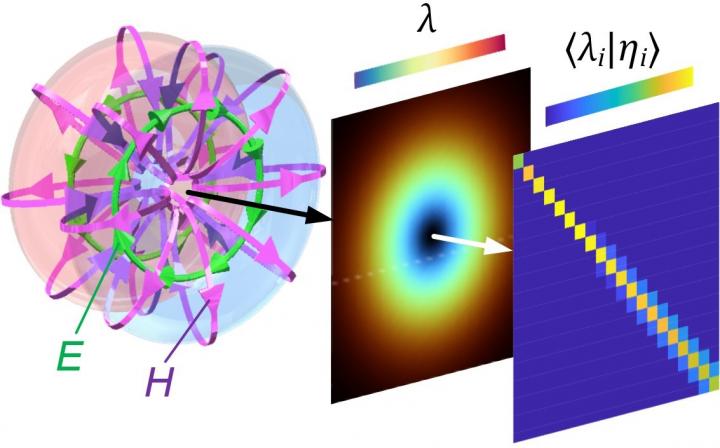Measuring space-time ‘entanglement’ of electromagnetic waves

Toroidal dipole-like vector electromagnetic field, space-frequency entangled distribution, and diagonal tomography matrices verifying its entangled nature.
Credit by Yijie Shen
Extremely structured electromagnetic pulse carries not only the ultimate human dream of ultra-fast and ultra-intense energy extraction but also numerous extraordinary fundamental physical effects. As a traditional viewpoint, Electromagnetic pulses are typically treated as space-time (or space-frequency) separable solutions of Maxwell’s equations, where spatial and temporal (spectral) dependence can be treated separately. However, recent advances in structured light and topological optics have highlighted the nontrivial wave-matter interactions of pulses with complex space-time separability (STNS), as well as their potential for energy and information transfer.
Recently, a research team from University of Southampton, for the first time, proposed basic concepts and solid mathematics for STNS states of electromagnetic waves for quantitatively measuring STNS, based on a quantum-mechanics-inspired methodology. In analogy to nonseparability in quantum entangled state, the authors introduce the concept of space-spectrum nonseparable states to describe the space-time nonseparability of a classical electromagnetic pulse and apply the “quantum” state tomography method to reconstruct the corresponding density matrix, then calculate the fidelity, concurrence, and entanglement of formation dug out from quantum measure technique as their quantitative measures of classical STNS.
In their paper “Measures of space-time nonseparability of electromagnetic pulse”, the authors implement state tomography for the quantitative characterization of space-time “entangled” electromagnetic pulses and report on its application to the propagation of single-cycle toroidal pulses and wideband beams. Dealing with traditional monochromatic waves, spatial and temporal variables of Maxwell equations are separated naturally. For the cost of simplicity, it inevitably omits physical information at the same time. An example for exception is the spatiotemporal pulse, or vividly called “flying doughnuts” which is an ultrafast pulse tightly localized. For such pulse, it shows perfect STNS while propagating, which could be used as an ideal paradigm to study classical space-frequency entanglement.
Based on dynamics of flying doughnut pulses, they display a wideband spectral spectrum. With the introduction of normalized the position ratios and radical coordinates, the authors develop a concise mathematical representation. Compared with wideband Laguerre-Gaussian beam, such pulses interestingly emerge an isodiffraction picture, various frequency components diffract at the same rate, say, frequency state and spatial state are always “entangled”, which provides prerequisite for following construction of states.
Due to the STNS, accompanied with spatial step function, it is possible to establish a set of orthogonal normalized bases in order to accurately characterized such properties. The inner product of the established Hilbert Space can be experimentally detected with the help of CCD camera. Moreover, their approach can be readily expanded mixed states causing mixed entanglement. For further characterizing “entangled” nature, the authors introduce tomography for such isodiffracting pulses to reconstruct the density matrix for the previous states. Though density matrix tells the full story of entanglement, such information is not so straightforward. Thus, the authors use the quantum-analog measurement to calculate fidelity, concurrence and entanglement of formation.
Summarily, the authors groundbreakingly propose novel concepts featuring STNS of optical field based on FDs and carry out quantum-like methodology for measurement which further reveals the connections between classical and quantum regime as well as quantitatively characterizes the spatiotemporal evolution of general structured pulses. This work opens a new page of spatiotemporal classical entanglement and provides largely unexplored degree of freedom in structured light, leading to novel application in ultrahigh-capacity communication, high-security encryption, topology- and quantum-analogous system.
Media Contact
All latest news from the category: Physics and Astronomy
This area deals with the fundamental laws and building blocks of nature and how they interact, the properties and the behavior of matter, and research into space and time and their structures.
innovations-report provides in-depth reports and articles on subjects such as astrophysics, laser technologies, nuclear, quantum, particle and solid-state physics, nanotechnologies, planetary research and findings (Mars, Venus) and developments related to the Hubble Telescope.
Newest articles

A new class of cosmic X-ray sources discovered
An international team of astronomers, led by researchers from the Astronomical Observatory of the University of Warsaw, have identified a new class of cosmic X-ray sources. The findings have been…

An open solution to improving research reproducibility
Academic and industry scientists collaborate on a new method to characterize research antibodies. Structural Genomics Consortium researchers at The Neuro (Montreal Neurological Institute-Hospital) of McGill University, in collaboration with scientists…

Living in the deep, dark, slow lane
Insights from the first global appraisal of microbiomes in earth’s subsurface environments. Which microbes thrive below us in darkness – in gold mines, in aquifers, in deep boreholes in the…



